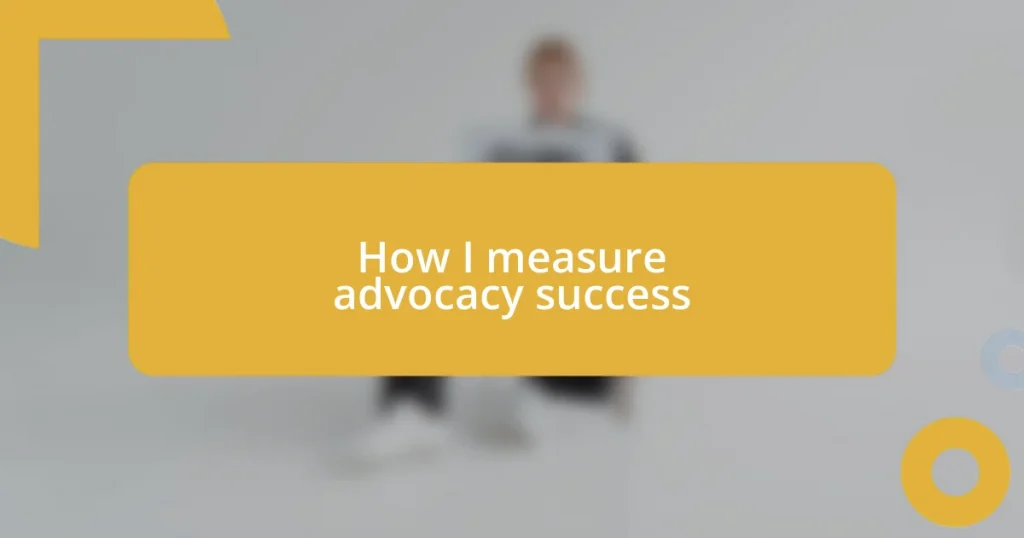Key takeaways:
- Establishing SMART goals clarifies advocacy objectives, providing direction and motivation for impactful actions.
- Success metrics should encompass both quantitative (numbers) and qualitative (emotions, community engagement) elements to evaluate true advocacy effectiveness.
- Consistent feedback and open dialogue with supporters enhance trust and inform strategies, ensuring advocacy resonates and leads to lasting change.

Understanding advocacy goals
Understanding advocacy goals is essential for creating a meaningful impact. When I first embarked on my advocacy journey, I found myself asking, “What exactly do I want to achieve?” Defining clear goals provides direction; it’s like having a roadmap.
To put it simply, advocacy goals should be specific, measurable, achievable, relevant, and time-bound—often referred to as SMART goals. For instance, instead of saying, “I want to help animals,” I focused on a specific objective: “I intend to increase spay and neuter rates in my community by 25% within six months.” This clarity not only motivated me but also helped me track my progress.
Sometimes, I realize that my goals evolved as I learned more about my cause. What I thought would be a straightforward advocacy effort morphed into a multifaceted campaign. I started wondering, “How can I reach more people?” Engaging in dialogue with the community opened new avenues for support and awareness, highlighting the importance of flexibility in advocacy goals.

Defining success metrics
Defining success metrics in advocacy is like crafting a personalized scorecard for your efforts. I remember attending a workshop where I learned to develop metrics that directly aligned with my advocacy goals. At first, I thought about metrics solely in numbers—how many events I organized or how many people I reached. However, I soon realized that success metrics also encompass deeper emotional connections, such as community engagement and the level of awareness we raise.
Here’s a breakdown of key success metrics to consider:
- Quantitative Metrics: Number of signatures collected, donations raised, or social media shares.
- Qualitative Metrics: Changes in community sentiment, personal stories shared, or testimonials from those affected.
- Engagement Levels: Attendance at events, participation in discussions, and social media interactions.
- Policy Impact: Changes in local laws or policies that reflect your advocacy efforts.
- Partnership Development: Number of collaborations with other organizations or community leaders gained.
By evaluating both the numerical and emotional impacts, I gained a more comprehensive view of what successful advocacy truly entails. This holistic approach doesn’t just quantify my achievements but also helps me connect and resonate with the people I’m striving to help.

Tracking engagement and reach
Tracking engagement and reach is crucial for understanding the effectiveness of advocacy efforts. When I started tracking engagement metrics, I was surprised at how much insight I gained from analyzing social media interactions. It wasn’t just about likes or shares; I learned to appreciate the comments and discussions that indicated genuine interest and engagement. Each interaction felt like a mini victory, showing me that my messages were resonating with the community.
I’ve also found that analyzing the reach of my advocacy campaigns helps me identify areas for improvement. For instance, after conducting a recent online event, I delved into the data and discovered that while we had a decent turnout, our follow-up engagement was lacking. This prompted me to create a more structured follow-up plan. Incorporating feedback from participants helped me refine my strategy and better connect with my audience moving forward.
To gauge engagement effectively, I use a combination of tools and platforms. Social media analytics, website traffic reports, and even simple surveys provide invaluable data for tracking how well my advocacy messages are being received. My experience has taught me that consistent monitoring can illuminate the path toward better practices, always aimed at fostering deeper connections with the community.
| Engagement Metrics | Description |
|---|---|
| Social Media Interactions | Comments, shares, and likes across platforms. |
| Event Attendance | Number of participants at advocacy events. |
| Website Traffic | Analytics on unique visits and page views related to advocacy content. |
| Survey Feedback | Direct insights from the community on their thoughts and feelings about advocacy efforts. |

Analyzing supporter feedback
When it comes to analyzing supporter feedback, I’ve learned that diving deep into the emotions behind the numbers can be revealing. For instance, during one campaign, I received a heartfelt message from a supporter who shared how our advocacy work had impacted their life. It struck me how much these personal stories illuminate not just success but the very essence of why we advocate. Have you ever had a moment where feedback made you rethink your approach? Those moments are invaluable; they provide lessons that metrics alone can’t teach.
I often utilize surveys and feedback forms after events to gather insights directly from my supporters. I remember the time after a community meeting when I was surprised to discover how many attendees felt disconnected from the topic, despite the enthusiasm I thought was clear. This feedback prompted me to adjust my communication style, making it more relatable and engaging. It became clear that understanding how our supporters feel can reshape our messaging and strategies significantly. Do you think a single piece of feedback could change your course of action? I truly believe it can.
Moreover, I find it essential to create a culture of open dialogue with my supporters. I’ve experimented with informal check-ins, asking for thoughts not just about my initiatives, but about their experiences and feelings related to the cause. This makes supporters feel valued and heard, shifting feedback from mere data points to authentic conversations. Isn’t it amazing how a simple conversation can enhance trust and loyalty within the community? Reflecting on these interactions tells me that advocacy is as much about listening as it is about leading.

Measuring policy impact
Measuring policy impact isn’t just about tracking statistics; it involves understanding the genuine change advocacy efforts bring to communities. I recall a time when I supported a policy change concerning local environmental issues. After the successful implementation, I visited the area to witness firsthand the differences the new regulations made. Seeing cleaner parks filled with families enjoying nature was a direct testament to the positive impact we had achieved, and it reinforced my commitment to advocacy.
In my experience, one effective way to measure policy impact is by collecting qualitative data through interviews with key stakeholders. For instance, discussing the changes with policymakers, community leaders, and residents revealed nuanced perspectives I hadn’t considered before. I remember speaking with a local business owner who shared how the new policy not only improved environmental conditions but also boosted their business due to increased foot traffic. Such personal stories underscore hard data, illuminating the broader effects of our advocacy work.
It’s essential to ask ourselves: how do we know if our advocacy truly matters? Sometimes, the metrics we rely on, like the number of policies passed, don’t tell the complete story. I’ve often found that anecdotal evidence—real stories of change, whether large or small—provides a more meaningful gauge of our impact. Reflecting on these narratives fills me with pride and purpose, reminding me that advocacy is ultimately about the people we strive to serve.

Evaluating long-term changes
Evaluating long-term changes in advocacy requires looking beyond immediate outcomes. I remember when my organization advocated for better mental health resources in schools. A few years later, I attended a local conference on education, and a teacher approached me. She shared how our efforts contributed to implementing a wellness program that profoundly impacted students’ emotional health. Hearing the ripple effect of our work planted seeds of hope in me, demonstrating how advocacy can create lasting change.
Tracking long-term changes involves monitoring ongoing community engagement. I once facilitated a workshop aimed at raising awareness about climate change. Months later, I received an email from a participant who started an eco-club at her school, inspiring her peers to take action. These stories are crucial; they highlight not only how our initiatives resonate over time but also how they forge new connections and drive momentum. It makes me wonder, how many such stories are waiting to be uncovered?
Of course, it’s essential to reassess our goals continually. When evaluating the longevity of changes, I ask myself how well I’ve communicated my vision to stakeholders. I vividly recall presenting at a town hall meeting, where the initial resistance I faced transformed into enthusiastic support as the years passed. This evolution reminded me that sometimes, it takes time for advocacy initiatives to take root and flourish. It’s something to consider: how much patience should we invest in seeing the fruits of our labor?

Reporting and communicating results
When it comes to reporting and communicating results, I believe clarity is paramount. I’ve seen firsthand how detailed progress reports can transform skepticism into support. At one point, I shared a comprehensive report with our community, outlining not only the statistics but also personal stories from those directly affected by our advocacy. The change in atmosphere was palpable; suddenly, those numbers felt real, inspiring more people to get involved.
Another key aspect is the emotional resonance of our messaging. I remember crafting a newsletter that included both quantitative data and heartfelt testimonials. One standout was a letter from a young advocate whose life had been positively impacted by our program. Her words not only showcased the numbers behind our success but also conveyed the profound significance of our work. It’s a question I often ponder: how can we consistently convey such powerful narratives in our communications?
Let’s not forget the digital age we live in, which offers endless avenues for outreach. I’ve leveraged social media to showcase our achievements, sharing stories through videos that highlight individual experiences. It prompts a different kind of engagement. I often ask myself—how can we make these stories shareable so others feel inspired to act? Communicating results isn’t just about metrics; it’s about sparking passion and connection within a community, reminding us that advocacy is truly a collective journey.















